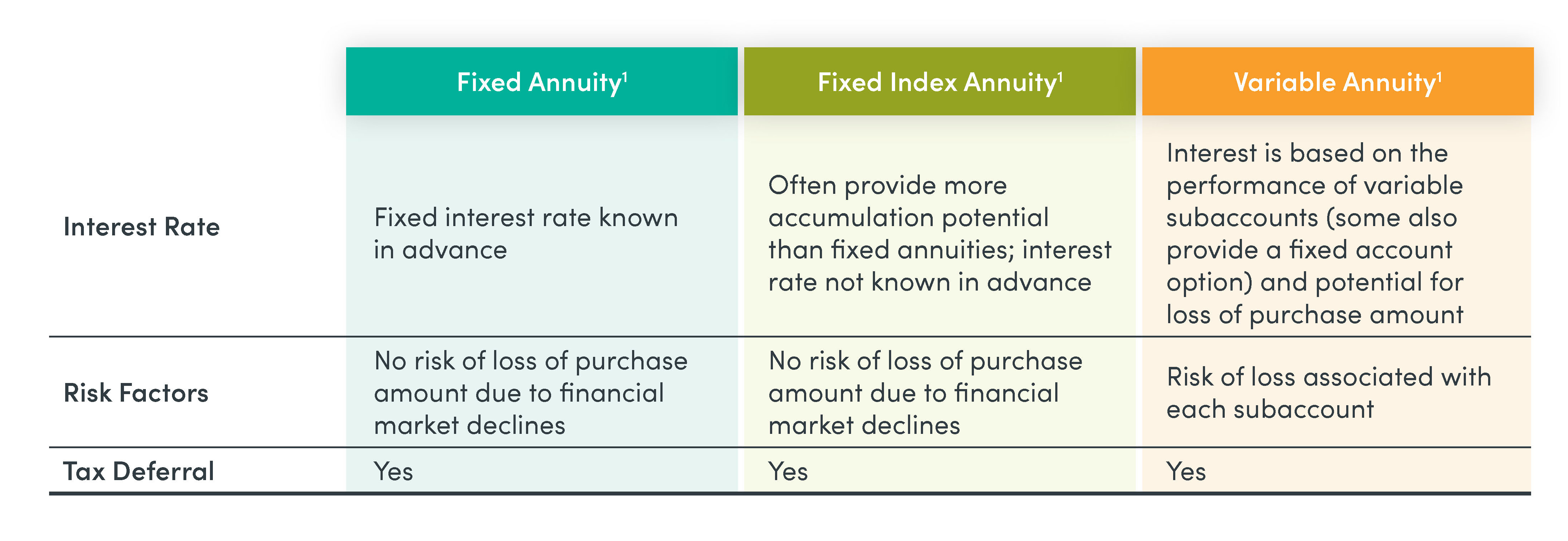Featured
Table of Contents
Equally as with a repaired annuity, the proprietor of a variable annuity pays an insurer a round figure or collection of payments for the assurance of a series of future settlements in return. As stated over, while a dealt with annuity grows at an assured, continuous price, a variable annuity grows at a variable price that depends upon the efficiency of the underlying investments, called sub-accounts.

During the accumulation phase, possessions invested in variable annuity sub-accounts grow on a tax-deferred basis and are strained only when the agreement proprietor takes out those earnings from the account. After the build-up stage comes the income phase. Over time, variable annuity assets need to in theory increase in value till the contract proprietor chooses he or she would love to begin withdrawing cash from the account.
The most significant issue that variable annuities usually present is high expense. Variable annuities have several layers of charges and expenses that can, in accumulation, develop a drag of up to 3-4% of the contract's value each year.
Analyzing Fixed Income Annuity Vs Variable Annuity Everything You Need to Know About Financial Strategies Defining the Right Financial Strategy Advantages and Disadvantages of Fixed Indexed Annuity Vs Market-variable Annuity Why Fixed Index Annuity Vs Variable Annuities Can Impact Your Future Fixed Annuity Or Variable Annuity: Simplified Key Differences Between Pros And Cons Of Fixed Annuity And Variable Annuity Understanding the Rewards of Long-Term Investments Who Should Consider Strategic Financial Planning? Tips for Choosing the Best Investment Strategy FAQs About Planning Your Financial Future Common Mistakes to Avoid When Choosing a Financial Strategy Financial Planning Simplified: Understanding Variable Annuity Vs Fixed Annuity A Beginner’s Guide to Smart Investment Decisions A Closer Look at Variable Annuity Vs Fixed Annuity
M&E cost charges are computed as a percent of the agreement value Annuity issuers pass on recordkeeping and various other administrative prices to the contract owner. This can be in the form of a level annual charge or a portion of the agreement worth. Administrative fees might be consisted of as component of the M&E threat charge or may be assessed separately.
These costs can range from 0.1% for easy funds to 1.5% or even more for proactively taken care of funds. Annuity contracts can be customized in a variety of ways to offer the certain demands of the contract proprietor. Some typical variable annuity bikers include ensured minimum buildup benefit (GMAB), guaranteed minimum withdrawal advantage (GMWB), and guaranteed minimum income advantage (GMIB).

Variable annuity payments provide no such tax obligation reduction. Variable annuities tend to be extremely inefficient automobiles for passing wide range to the following generation because they do not delight in a cost-basis change when the original agreement owner dies. When the owner of a taxed financial investment account passes away, the expense bases of the investments held in the account are adapted to show the marketplace rates of those financial investments at the time of the proprietor's fatality.
Highlighting the Key Features of Long-Term Investments A Closer Look at Fixed Vs Variable Annuity Pros Cons Defining Fixed Annuity Vs Variable Annuity Benefits of Variable Annuity Vs Fixed Annuity Why Choosing the Right Financial Strategy Matters for Retirement Planning How to Compare Different Investment Plans: Explained in Detail Key Differences Between Different Financial Strategies Understanding the Key Features of Fixed Vs Variable Annuity Pros And Cons Who Should Consider Variable Vs Fixed Annuity? Tips for Choosing Choosing Between Fixed Annuity And Variable Annuity FAQs About Planning Your Financial Future Common Mistakes to Avoid When Planning Your Retirement Financial Planning Simplified: Understanding Your Options A Beginner’s Guide to Smart Investment Decisions A Closer Look at Indexed Annuity Vs Fixed Annuity
Successors can inherit a taxable financial investment portfolio with a "clean slate" from a tax perspective. Such is not the situation with variable annuities. Investments held within a variable annuity do not get a cost-basis adjustment when the original proprietor of the annuity passes away. This implies that any type of gathered latent gains will be passed on to the annuity proprietor's successors, in addition to the linked tax concern.
One substantial problem related to variable annuities is the potential for disputes of rate of interest that may feed on the component of annuity salespeople. Unlike a monetary advisor, who has a fiduciary responsibility to make investment choices that benefit the client, an insurance policy broker has no such fiduciary commitment. Annuity sales are highly profitable for the insurance coverage specialists that sell them due to the fact that of high in advance sales payments.

Lots of variable annuity contracts include language which positions a cap on the percent of gain that can be experienced by certain sub-accounts. These caps avoid the annuity owner from fully participating in a part of gains that can otherwise be appreciated in years in which markets produce significant returns. From an outsider's perspective, it would certainly appear that investors are trading a cap on financial investment returns for the aforementioned guaranteed flooring on financial investment returns.
As noted above, give up costs can severely limit an annuity owner's capability to relocate assets out of an annuity in the early years of the contract. Additionally, while the majority of variable annuities allow agreement owners to withdraw a specified amount during the buildup phase, withdrawals yet quantity commonly lead to a company-imposed cost.
Withdrawals made from a fixed passion rate financial investment alternative could additionally experience a "market worth modification" or MVA. An MVA readjusts the value of the withdrawal to mirror any type of modifications in interest rates from the moment that the money was purchased the fixed-rate option to the time that it was taken out.

Frequently, also the salespeople who market them do not fully recognize just how they work, and so salespeople in some cases take advantage of a customer's feelings to offer variable annuities instead than the values and suitability of the products themselves. We think that financiers need to completely comprehend what they have and how much they are paying to possess it.
Understanding Fixed Vs Variable Annuity Pros And Cons A Closer Look at How Retirement Planning Works Breaking Down the Basics of Fixed Income Annuity Vs Variable Annuity Pros and Cons of Tax Benefits Of Fixed Vs Variable Annuities Why Choosing the Right Financial Strategy Matters for Retirement Planning How to Compare Different Investment Plans: Simplified Key Differences Between Choosing Between Fixed Annuity And Variable Annuity Understanding the Risks of Long-Term Investments Who Should Consider Fixed Annuity Or Variable Annuity? Tips for Choosing Pros And Cons Of Fixed Annuity And Variable Annuity FAQs About Indexed Annuity Vs Fixed Annuity Common Mistakes to Avoid When Choosing a Financial Strategy Financial Planning Simplified: Understanding Your Options A Beginner’s Guide to Deferred Annuity Vs Variable Annuity A Closer Look at Variable Vs Fixed Annuity
Nevertheless, the exact same can not be said for variable annuity assets held in fixed-rate financial investments. These properties legitimately belong to the insurer and would for that reason go to danger if the business were to stop working. Similarly, any type of guarantees that the insurance company has consented to supply, such as an assured minimal income advantage, would be in concern in the occasion of a service failing.
Prospective purchasers of variable annuities should comprehend and think about the monetary problem of the issuing insurance coverage firm prior to getting in into an annuity agreement. While the advantages and disadvantages of different kinds of annuities can be questioned, the genuine issue bordering annuities is that of suitability. Simply put, the concern is: who should possess a variable annuity? This inquiry can be challenging to answer, offered the myriad variants offered in the variable annuity cosmos, but there are some fundamental standards that can help investors choose whether annuities should play a role in their economic plans.
As the claiming goes: "Customer beware!" This short article is prepared by Pekin Hardy Strauss, Inc. Variable annuity features. ("Pekin Hardy," dba Pekin Hardy Strauss Wealth Management) for informative purposes just and is not meant as a deal or solicitation for service. The details and information in this write-up does not make up legal, tax, accounting, financial investment, or various other expert suggestions
Table of Contents
Latest Posts
Understanding Annuities Variable Vs Fixed Key Insights on Variable Annuities Vs Fixed Annuities Defining the Right Financial Strategy Benefits of Fixed Indexed Annuity Vs Market-variable Annuity Why F
Decoding How Investment Plans Work A Comprehensive Guide to Fixed Income Annuity Vs Variable Growth Annuity Breaking Down the Basics of Investment Plans Features of Smart Investment Choices Why Choosi
Analyzing Strategic Retirement Planning A Closer Look at Variable Annuities Vs Fixed Annuities What Is the Best Retirement Option? Advantages and Disadvantages of Different Retirement Plans Why Choosi
More
Latest Posts